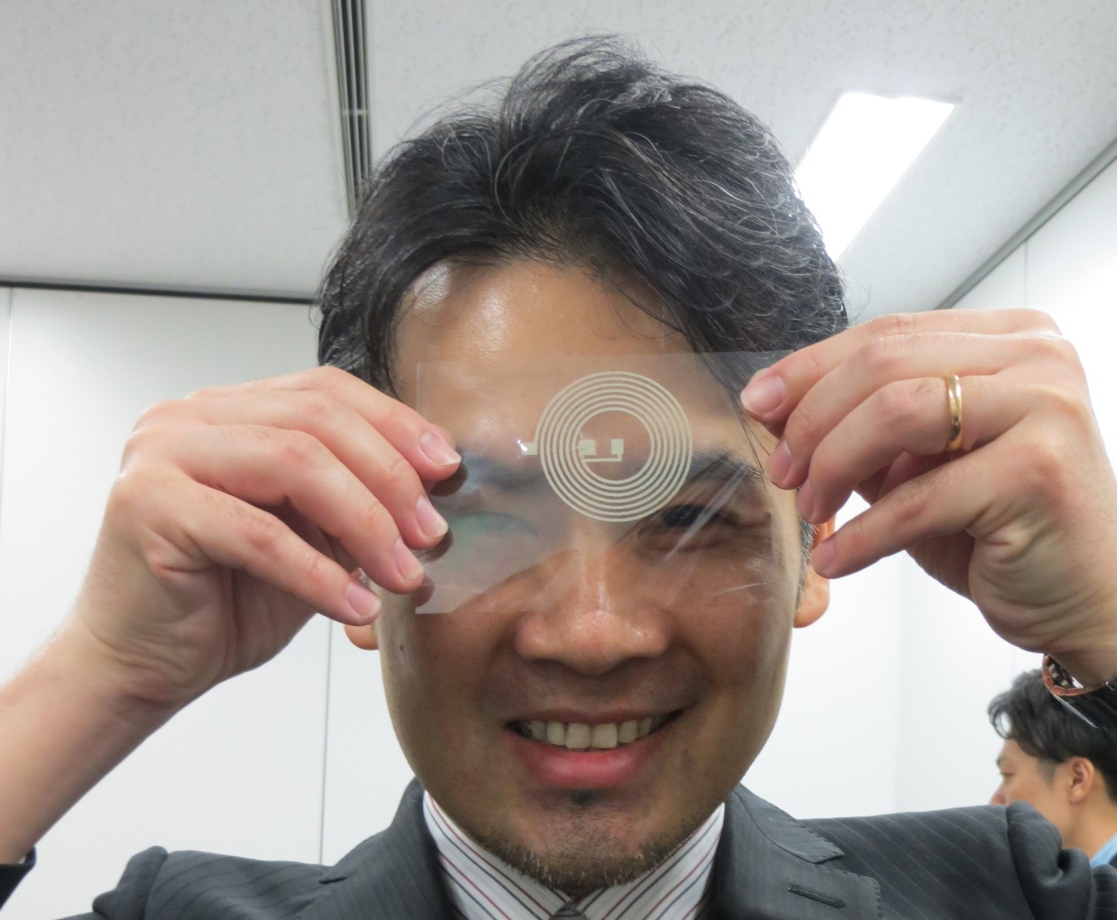Waseda Frontline Research Vol. 16: Assistive robot technology to expand human functions (Part 1 of 4)
Wed, Sep 6, 2017-
Tags
Hiroyasu Iwata, Professor, Faculty of Science and Engineering, Waseda University
Global Robot Academia Laboratory Director
Specialization: Medical welfare robotics and mechatronics
The thin and soft electronic tattoos
 “We can’t let robots make us lazy,” says Professor Hiroyasu Iwata. He is conducting a variety of research around the concept of human assistive robot technology (RT) to expand physical performance and functions. This four-part series of interviews by Waseda’s Center for Research Strategy will present major topics related to the cutting-edge technologies he is working on. The first technology is electronic tattoos.
“We can’t let robots make us lazy,” says Professor Hiroyasu Iwata. He is conducting a variety of research around the concept of human assistive robot technology (RT) to expand physical performance and functions. This four-part series of interviews by Waseda’s Center for Research Strategy will present major topics related to the cutting-edge technologies he is working on. The first technology is electronic tattoos.
Measuring physical condition in real time
“Smart” is a trendy keyword that has led to new innovations in recent years, ranging from smartphones to smartwatches, smartglasses, and even smartwear. In the IT field, smart refers to something that is informatized, meaning, equipped with information processing functions. Specifically, wearable devices for the skin, including smartwear, are drawing attention as a tool to constantly capture biological information, such as body temperature and pulse rate. Smartwear applications fall into two major categories: One application is constantly checking the physical condition of elderly people, and the other is monitoring real-time physical conditions of athletes to manage their performance during exercise. To achieve this, it is necessary to find a way to attach sensors.

Figure: Device that monitors physical condition using a nano-sheet substrate worn on the skin (Source: Iwata Laboratory)
Ultra-conformable wearable devices
Generally with smartwear, sensors are embedded into shirts or underwear. Because the sensors come into contact with the skin, the person wearing the device will inevitably become conscious of it. Moreover, cables become necessary to connect the power supply and data-transmission devices. When these parts come into contact with the human body, it will further increase discomfort. Some elderly users may experience a vague discomfort and unconsciously try to unplug the cables. Sensitive athletes may find that having cables in contact with their skin can influence their mental condition, hampering precise measurement of their performance.
In order to address these problems, we began to develop a wearable device that feels almost bare. If we were to describe it using the buzzword “smart,” we could call it a smart patch. It is a small, thin measurement device that sticks on to the arm for application. The size is set as 4 cm squared or less with thickness of less than 1 micron. This thinness induces a unique attraction known as the van der Waals force, which allows the patch to naturally stick to the skin. For power feeding and data measurement/transmission, the patch uses a combination of smartphones and NFC (near-field communication; very short-distance wireless communication ranging from a few centimeters to a meter which enables wireless power feeding). Once a smartphone is placed nearby, power feeding and data transmission are completed instantly. Sticking a small patch to the skin is all it takes. There is no need to use other parts including power supply cables, so the small patch fits to the skin without almost any discomfort.
Embedding electronic devices into nanosheets
First off, we had to find out how to precisely measure the required data while maintaining appropriate thinness for conformity. For practical use, further consideration was needed to also decrease production costs. To this end, we came up with the idea of converting ultra-thin sheets for data collection into electronic devices. In fact, electronic circuits were printed onto a sheet with a thickness of about 400 nm (one 2500th of a millimeter). However, it would be expensive to use unconventional printing methods. To reduce costs for practicality, we developed a new technology that designs and prints circuits with a household ink-jet printer. An ultra-thin sheet with an ink-receptive layer is laminated on a printed electronic circuit, and the adhesive force between nanosheets steadily fixes these electronic elements onto the nanosheets. If you add a drop of water to these sheets and place them on the skin, they stick naturally.
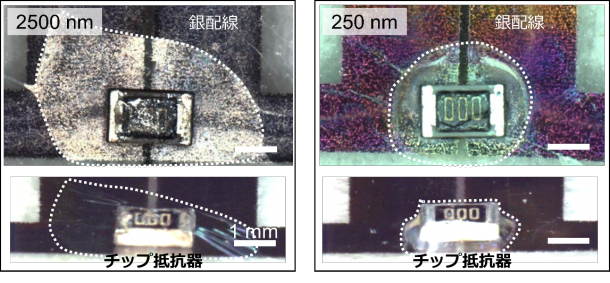
Figure: Chip resistors between silver conductors, which are sealed with SBS (styrene-butadiene-styrene). Left: A nanosheet of 2500 nm thickness. Right: A nanosheet of 250 nm thickness. Inside the dotted white line, the nanosheet for sealing is separate from the substrate and therefore it does not stick. We were able to enhance the tightness by sealing it with a thinner nanosheet that fits more closely. (For details: “Waseda team produces innovation for ultra-conformable “electronic tattoos”)
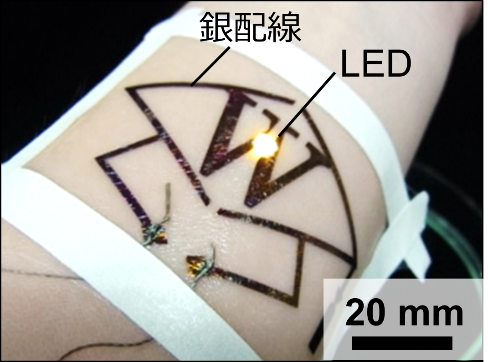
Photo: An LED lighting circuit mounted on an SBS nanosheet stuck on a user’s arm. The electric connection between the conductor and the LED is stable even on the skin, and the sheet sticks like a plastic wrap.
The sheet can take biological data such as body temperature, pulse rate, blood pressure, blood oxygen level, muscle potential, and even skin moisture and skin acidity. Changing the design of the circuits makes it possible to collect all kinds of data. One remaining issue is reducing the electric resistance of the circuits printed on the sheet. Thickening the circuit reduces the resistance, but also results in a thicker sheet. This thickening may also weaken the force of the upper and lower sheets sandwiching the circuit. We are looking for solutions for this trade-off problem to achieve the lowest circuit resistance while keeping the circuit as thin as possible.
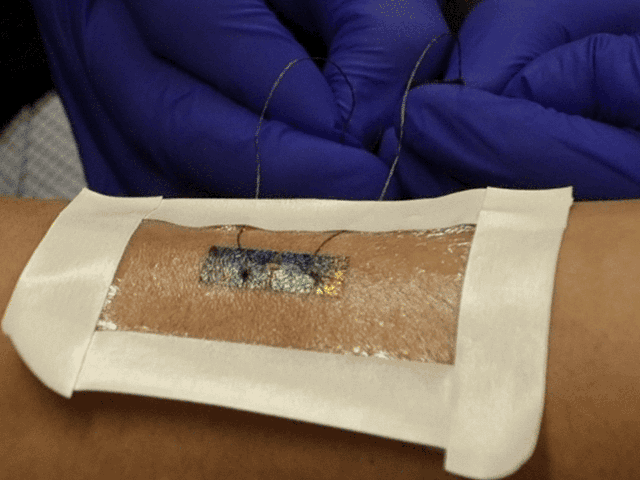
Photo: A circuit when it is turned on
For application in the 2020 Tokyo Olympics
The mechanism of biomedical measurement devices can be used for other applications, too. I have two ideas: electronic tickets that stick to the human body and skin acidity sensors. For the electronic ticket, for example, imagine something like a contactless smart card (“Suica”) made into a very thin, small, and soft sheet. This sheet is stuck on the wrist or elsewhere and used as a ticket. The electric circuits required for the ticket are embedded inside the sheet, and NFC communication makes external information exchange possible. The mechanism of how it works is exactly the same as that of a contactless smart card, so it is applicable for practical use if the circuits can be printed on an ultrathin sheet. We’re looking forward to using this technology in admission tickets for the 2020 Tokyo Olympics. When people from around the world are handed smart tickets instead of typical paper tickets, can you picture how surprised they will be? I believe that this is the best opportunity to showcase Japanese technologies to the world.

Photo: Sticking on a nanosheet. A step closer to realizing electronic tickets.
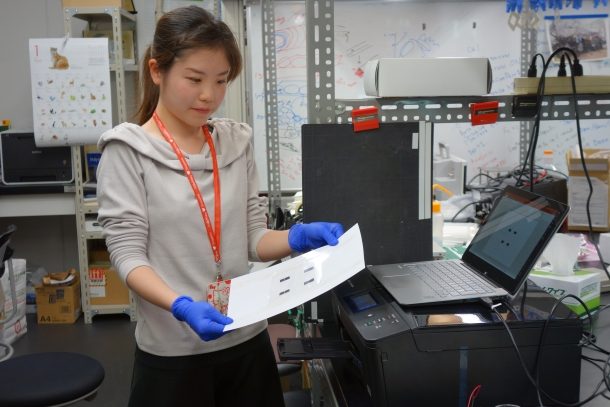
Photo: Conductors in electronic circuits can be designed and printed with a household ink-jet printer. Anyone can easily produce them at low cost because nanosheets are used as the printing base and sealing material.
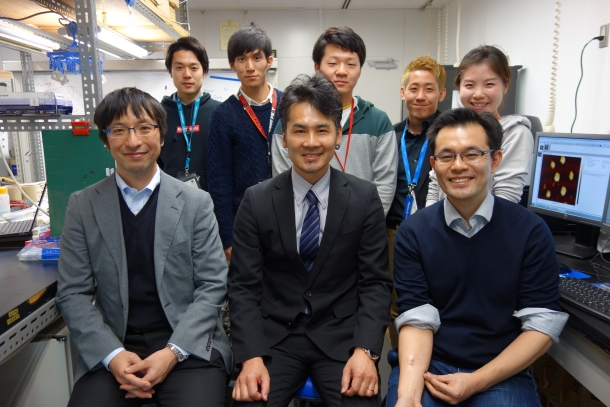
Photo: Members of the electronic tattoo team (“Polymeric ultrathin film into electronic devices and its biomedical applications”). They are also members of a young researcher’s team at the Institute of Advanced Active Aging Research, where they are integrating the specialties of young researchers. From left: Associate Professor Eiji Iwase, Professor Hiroyasu Iwata (research representative), and Assistant Professor Toshinori Fujieda (Shinji Takeoka Laboratory)
The other idea, the acidity sensor, measures the pH level of the human skin. It uses nanosheets like other biomedical devices, but what is sandwiched between these sheets is not an electronic circuit, but instead a particular pH sensor (an ion-sensitive field-effect transistor: ISFET*). The skin is the surface of the human body. Therefore, it acts a protection barrier against bacteria and other external threats. As stress accumulates, openings form in the barrier. Bacteria enter through these openings and induce symptoms such as inflammation. As a preventive measure, we can wear a sensor that constantly measures skin pH to check skin condition at any time. When the barrier is damaged, we can use things like skin cream to take care of our skin. Although more time is needed before the practical use of this technology, it will surely be beneficial for women and people with sensitive skin.
The second part of this series will take a close look at a human assistive robot technologies (RT) called the third arm.
* ISFET (Ion Sensitive Field Effect Transistor): An FET whose gate surface is covered with an ion sensitive layer, which measures the interfacial potential between the electrolyte liquid and the ion (proton) sensitive layer, generated by the ion activity of the liquid.
Profile
 Professor Hiroyasu Iwata
Professor Hiroyasu Iwata
Professor Hiroyasu Iwata obtained his Ph.D. in mechanical engineering from the Graduate School of Science and Engineering at Waseda University in 2002. After serving as lecturer and associate professor, he was appointed professor at the Faculty of Science and Engineering in 2014, and laboratory director at the Global Robot Academia in 2015. Professor Iwata is a member of Japan Society of Mechanical Engineers (Delegate), Japan Society of Computer Aided Surgery (Trustee), Society of Biomechanisms Japan (Secretary), Robotics Society of Japan (Trustee), Japanese Society of Biofeedback Research (Executive Director), Society of Instrument and Control Engineers (Delegate), IEEE, EMBS and so on. Professor Iwata has earned a good reputation in Japan and overseas for his involvement in many cutting-edge research projects under the keyword of human assistive Robot Technology, including rehabilitation assistive RT, medical care assistive RT, sports learning assistive RT, intelligent construction equipment robotics, and RT using new materials. Contact the Iwata Laboratory for further details.
Major research achievements
- M.OKAMOTO,M.KUROTOBI,S.TAKEOKA,J.SUGANO,E.IWASE,H.IWATA,T.FUJIE,“Sandwich fixation of electronic elements using free-standing elastomeric nanosheets for low-temperature device processes” J.Mater.Chem.C,Feb,2017
- H.HAYATA,M.OKAMOTO,S.TAKEOKA,E.IWASE,T.FUJIE,H.IWATA,“Printed high-frequency RF identification antenna on ultrathin polymer film by simple production process for soft-surface adhesive device” Jpn.J.Appl.Phys.,vol.56,no.5S2,pp.05EC01,May,2017
- Ito K, Sugano S, Takeuchi R, Nakamura K, Iwata H,“Usability and performance of a wearable tele-echography robot for focused assessment of trauma using sonography” Medical Engineering and Physics,vol.35,no.2,p165-171,2013
- Iwata H, Sugano S,“Human-robot-contact-state identification based on tactile recognition” IEEE Transactions on Industrial Electronics,vol.52,no.6,p1468-1477,2005
- Iwata H, Sugano S,“Design of human symbiotic robot TWENDY-ONE”Proceedings-IEEE International Conference on Robotics and Automation,p580-586,2009


